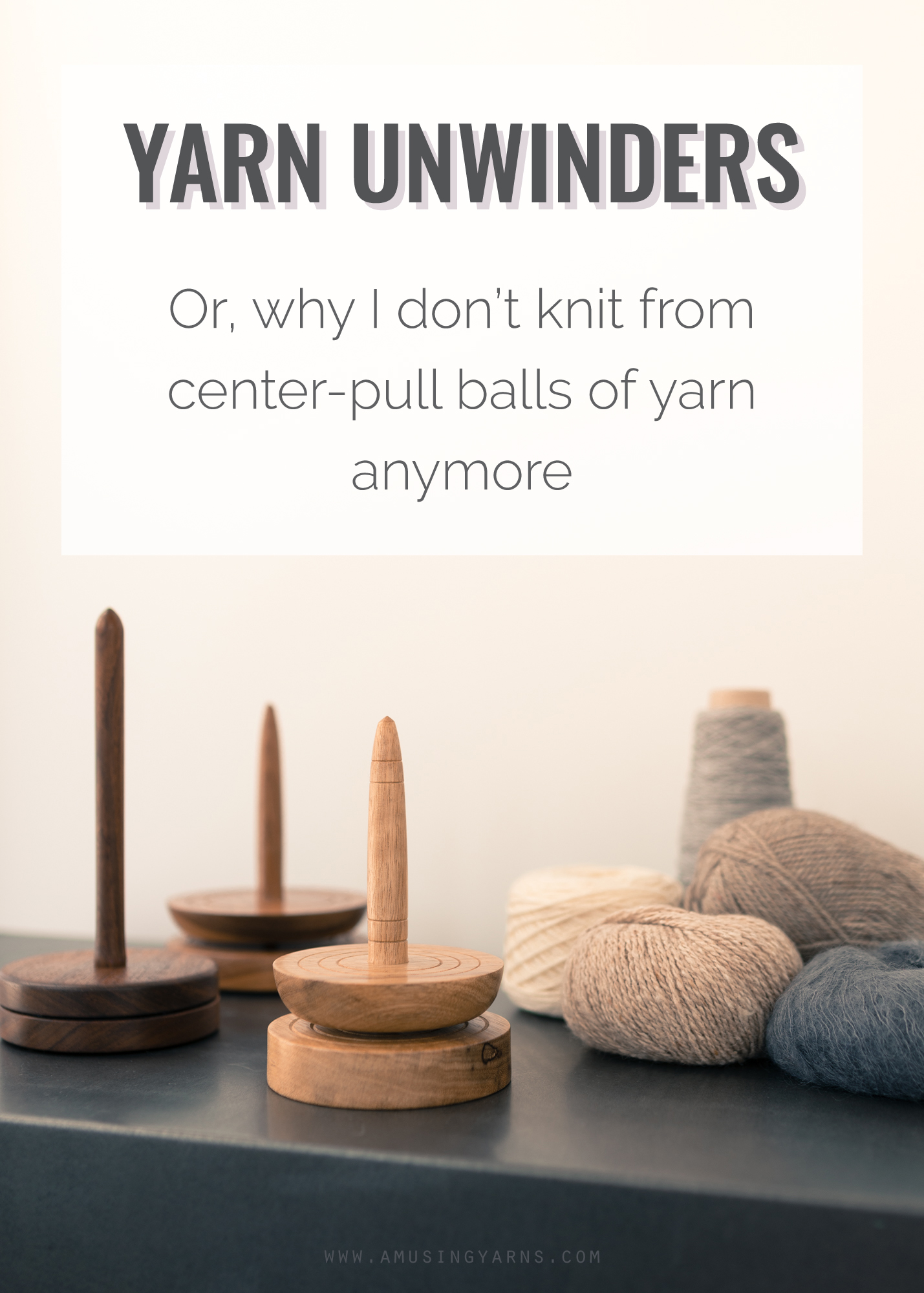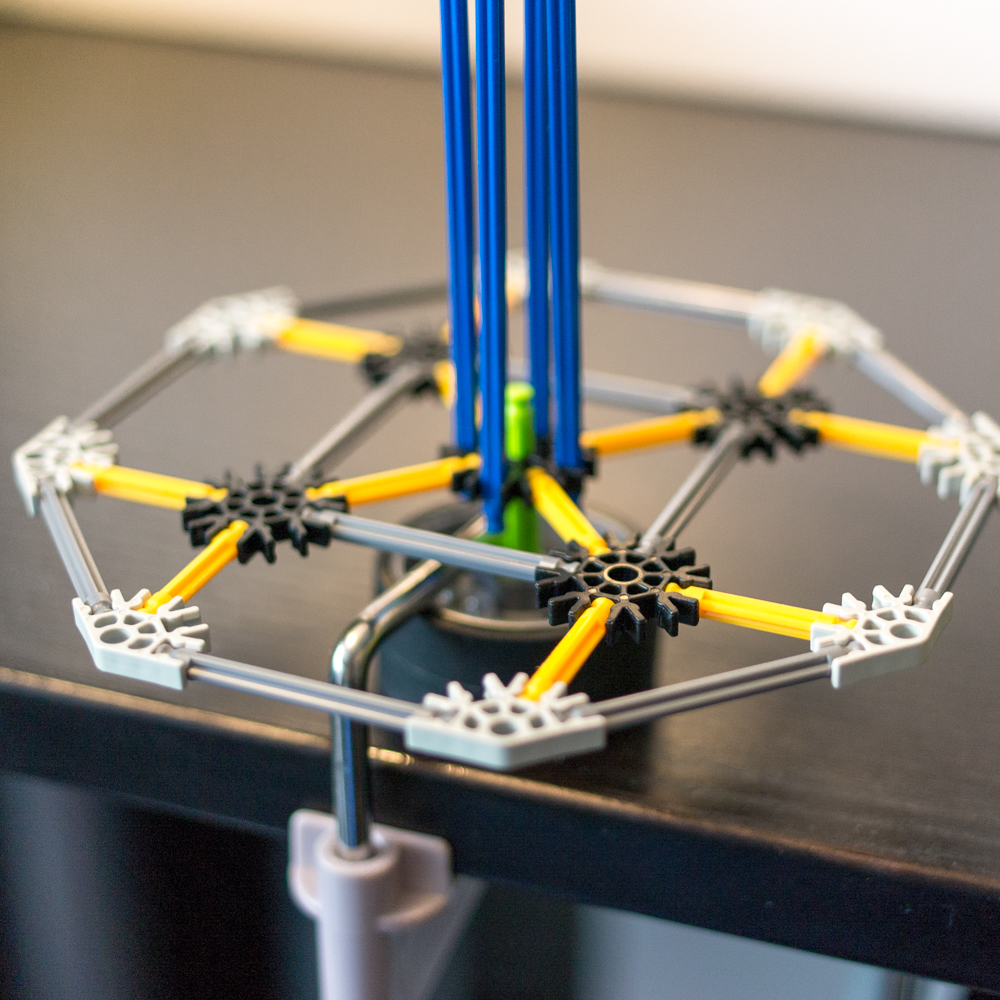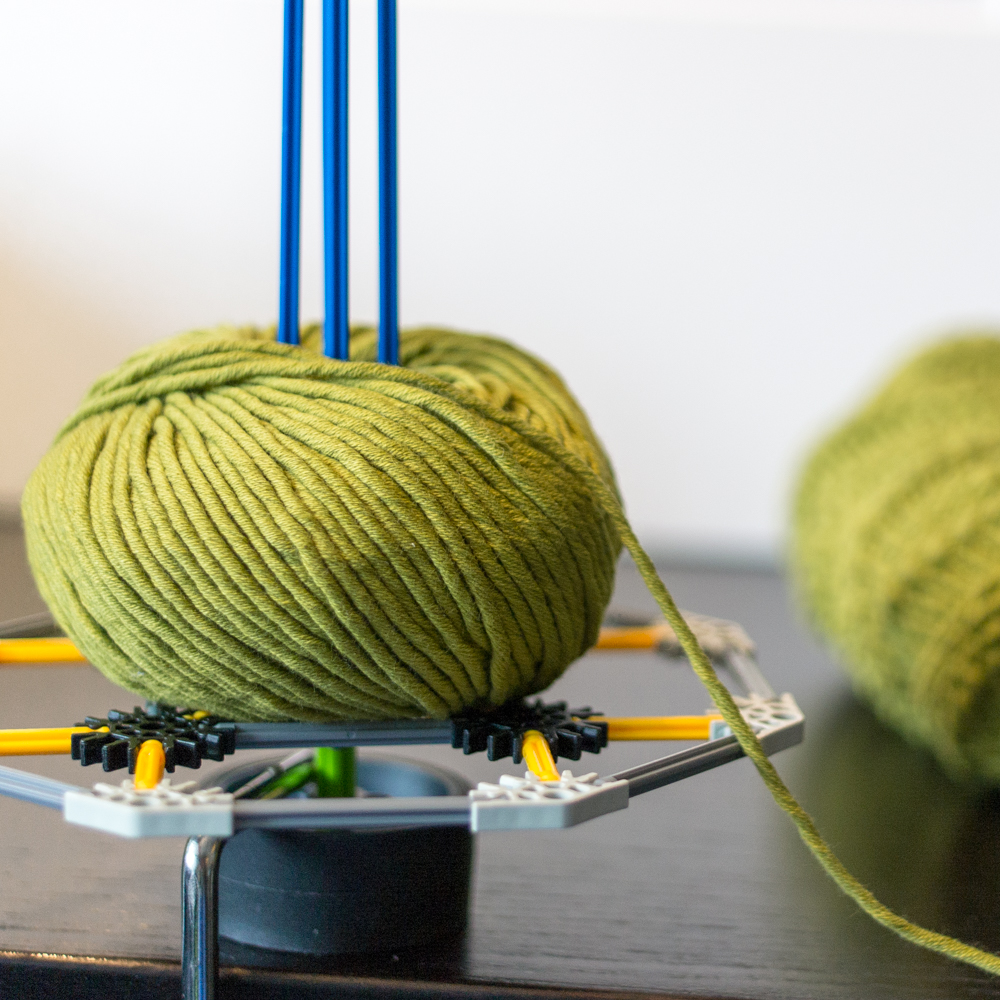Some three four months have elapsed since I first stated that I was starting a series of posts about knitting tools and today, at long last, I begin the first in what I hope will become a series of knitting tools posts. In that first post, I mentioned my love of tools in general and my intent to talk about some of the knitting tools I like but don’t often encounter mention of elsewhere (and when I say “elsewhere”, I promise you I have not scoured the internet to confirm).
Today’s tool topic is, erm, these things:
I have seen various names (some of them trademarked) applied to them but no real consensus on a single term.* This is possibly because they aren’t as widely in use as I would have thought (at least given how totally awesome I find them. Although, since I first wrote about these some five years ago, there are many more vendors selling their own versions, so possibly these aren’t as rare as I like to think.) People seem to like the names “yarn Lazy Susan” or “yarn spinner”. I guess I still call it a “yarn unwinder” even though it doesn’t quite roll off the tongue, because it is at least a bit more accurate than "yarn spinner", which to my mind, is a person who turns fiber into yarn. I’ll just quote myself and say that whatever you call it, I call it indispensable.**
You might be a little sceptical about how this device is any better than just pulling yarn from the center of a ball or using a yarn bowl--the former being simplicity itself and the latter being prettier. To address this question, I’m going to talk a bit about yarn management and the issue of added twist before I get to the actual yarn unwinders.
YARN MANAGEMENT
By “yarn management”, I mainly mean how you get your yarn off the ball while you are knitting and, when applicable, how you are taming that ball of yarn. Are you pulling from the center or are you pulling from the outside end? A center-pull ball is kind of self-managed--the beauty of it is that it calmly stays in one spot (for the most part) while you disembowel it. If you are pulling your yarn from the outside end, the ball requires taming or at least a long leash. If it isn’t rolling along the floor or being strong-armed to flip over the necessary number of times to allow you to knit a few more stitches, you are probably using a yarn bowl or some other containment device.
Part of the trouble with these aforementioned methods is that unwanted twist is being added to the yarn in the process.
(Although, to be more precise, the center-pull ball is definitely twisting the yarn as it is pulled out, whereas the second method of pulling yarn off the outside is a little more unpredictable because it’s usually just taking the path of least resistance which might not always be causing a twist. I find the slipperier the yarn, the more likely it is to just slip off the end instead of unrolling). If you are pulling yarn off the top of a cone, it is like pulling yarn from the center in that it is adding twist (or subtracting, depending).
If you require visual assistance, I made this entirely amateur video to try to demonstrate what's happening to the yarn.
THE TROUBLE WITH TWIST
My very first forays into knitting, I would just start from the outside end and pull the yarn off the ball, letting it roll and flip in any old direction. Then I was introduced to the magic of the center-pull ball and I thought it was pure genius. I sallied forth happily knitting from center-pull balls for years until one day, I was working on a blanket and the yarn was kinking up so badly that it wouldn’t slide over my tensioning finger. I was forced to untwist the yarn by dangling my project from the working yarn and letting it spin around until it regained equilibrium. By the third ball (of some twenty or so balls), I realised that this was not going to be a practical solution for the rest of the project. I had a lot of time to think about what was happening to my yarn during all those many un-twisting sessions and I came across this post by (the much more methodical) Tech Knitter. Suspicions confirmed. In order to solve my problem, I devised this little contraption out of K’nex:
(Photos unearthed from the archives.)
I finished the blanket without further incident and I’m glad I did because it has gotten a lot of use in the last several years. (In fact, I am currently huddling under it waiting for the weather to realize it's now spring.) My next project was a long cardigan knit from cones and there was no way I was going to risk knitting 1600 yards into an unwearable sweater by pulling the yarn off the top of the cone. (Edit: I discuss the issue of biasing a little more in the video—which I probably shouldn’t have assumed all readers would have watched. In short, a yarn with unbalanced twist can result in a biasing fabric.) Past experience had taught me that a biasing item cannot be fixed with blocking and it won’t end up getting worn more than once. I had to come up with another device (which was basically a cardboard shoe box with a long Sz.13 knitting needle mounted inside) to accommodate the height and weight of the cones because K’Nex is pretty weak when you come down to it. After those two projects, I decided I would never go back to the center-pull ball.
EVEN MORE REASONS TO USE A YARN UNWINDER
Now, I readily admit that countless people have knit an untold number of items successfully with center-pull balls so what I’m fussing about is those other occasions when your yarn keeps kinking up while you knit, or, worst of all, the knitted fabric biases due to the excess twist. This alone is reason enough for me to always use an unwinder, but wait, there’s more!
Consider this, when you use a yarn unwinder there is:
No fishing around the center of a ball in search of the end
No yarn barf
No collapsing of nearly finished yarn balls. You know what I’m talking about, those shells of their former selves. The yarn looks so sad like that and sometimes they get into a tangle, having lost their structural support
No more satellite center-pull balls. The other bane of the center-pull ball: having to frog something part way through the ball. You make a satellite center-pull ball which you cannot always stuff back into the original ball. The yarn unwinder in reverse suddenly becomes a yarn winder--you simply spin your frogged yarn back onto the ball
(I was already sold at “no yarn barf” but this last one is my favourite.)
(Ah, center-pull balls. Those were the days.)
WHY YOU MIGHT NOT LIKE AN UNWINDER
I may sound like I’m trying to convince you that you need and will be forever grateful to have a yarn unwinder in your life, so for the sake of a balanced perspective, I should probably mention a few of the potential cons of the yarn unwinder,
Portability. These are not the most conveniently portable of devices, but it's not as if you're putting a ceramic yarn bowl in your purse either
On the topic of portability, even if you are willing to pack it into your handbag or tote, you will find it rather difficult to knit straight out of the bag. You’ll need to take it out and set it on a surface. This will attract looks and if you are in stealth-mode knitting at the office, this is not your friend
Aesthetics. They mostly don’t look as pretty as yarn bowls. Some of the hand-crafted versions are quite nice, but really, especially out of context, they are a bit odd looking
Cats. I don’t currently own a cat, but plenty of knitters do. You know and I know that chances are this is going to get batted off the table as soon as you leave the room
Sound. They aren't completely silent and the version with the lazy Susan mechanism could drive a person with sensitive ears batty with those ball bearings racing around a metal track. I myself barely notice it, but that might be due to a misspent youth blasting music through my headphones
CHOOSING AND USING A YARN UNWINDER
There are two basic types of yarn unwinder. The first consists of a top portion that rests on a supporting base and rotates freely on the base's spindle. I call these "free-spinning" unwinders. The second is built with a "lazy Susan" mechanism that allows the top portion to spin around, hence, the "yarn lazy Susan". The model I own has a spindle which can be unscrewed from the base for flat-packing. Whichever type you choose, it should spin very smoothly and not require much force to rotate
Whichever type you choose, the base needs to be very stable. In other words, it needs to be heavy enough and/or wide enough that it can resist the force of the yarn being pulled off the ball. You don’t want it tipping over or sliding. Even the solid wood versions can start making their way towards the edge of a table so in this case, adding rubber feet helps if there aren’t some already
If you want a two-piece unwinder that spins freely on a base, it is really important that the top piece turns smoothly and freely on the base spindle. Also, this base spindle needs to be long enough and strong enough to hold this top securely so that it doesn't get pulled off while you’re working
The yarn unwinder should be set on a table or another stable surface and just as importantly, it needs to be at a height level to your hands or a little higher. If you set it lower than your work, you’ll find that the yarn wants to wrap around the post and will not feed smoothly. This shouldn’t be a problem if you get a version with a yarn guide. I have seen versions that have yarn guides built in or as separate attachments. Edited to add: I also recommend placing the unwinder to your right if you carry your working yarn in your right hand and to your left if you carry your yarn in your left hand--it's a small difference, but worthwhile if you find that the yarn isn't feeding smoothly.
Do not set it on the floor. Now the yarn is coming off the top of the ball or cone and the yarn unwinder is no longer doing what it’s meant to do. In other words, you are adding twist to your yarn and to make it worse, as the ball gets lighter, it will just keep getting pulled off the top of the post because it can’t resist the upward pull
If you are working from a larger or oblong skein, the post needs to be longer than the skein and I think this is when the yarn guide becomes very useful. I don’t have much experience working with skeins like this because I tend to wind everything into cakes, but if you regularly work with long skeins or gargantuan balls of yarn, you’ll need to make sure you get something appropriately sized. The ones I have are meant for the typical 50g or 100g put-ups you find for hand knitting yarns so you should look for versions that have wide bases that will prevent it from tipping over while you work or have a means of clamping to a surface
When working with coned yarns, stuffing some soft foam inside the cone will help the yarn unwinder do its job more efficiently. It prevents the cone from wobbling about. If you’re just setting the cone on something like a paper towel stand, don't stuff the cone because you need the lack of friction for the cone to turn since there's no other mechanism helping the cone to spin
I recommend purchasing in person or from a vendor with a good return policy. There are a lot of little variations from one manufacturer to the next and you might not find the right one for you if you choose on looks alone. You literally need to be able to “give it a whirl” first!
Lastly, this point is about hand-wound balls of yarn. Hand winding a ball of yarn will actually impart a twist to the yarn. So, if you are concerned with added twist, this is important to consider because the yarn unwinder won’t untwist yarn.***
ON A TIGHT BUDGET?
Regarding cost, if this is money you are unwilling to spend but you want to try some version of a yarn unwinder, you have options. I made low-tech and low-cost versions before I discovered I could pay someone to make one out of nicer materials for an amount that I was willing to part with.
If you want one for under $15 (USD), the Yarn Valet™ yarn dispenser is available through Knit Picks and Michael’s, and probably others as well. (I haven’t personally tried it out, so I can’t vouch for how well it works but there is a video review here.) If DIY is more your style, you can try hacking various common household items that you might already have or can find at a yard sale or thrift store. On Ravelry, I have seen the occasional mention of empty CD spindle cases, paper towel holders, standing toilet paper holders, and cardboard boxes/plastic bins with a knitting needle or dowel stuck through it. Tech Knitter has a DIY tutorial for a fairly hefty but very functional-looking version here.
I’ve tested out a few of these DIY options and it can work pretty well but I would say that generally speaking, it helps if you use something to decrease the friction so the yarn can rotate more readily. For instance, the CD case works better if you can put a large nut (or something like) under an actual compact disc (which I’m going to guess you don’t need anymore in this modern era) and then rest your yarn ball/cake on the disc. If using a paper towel stand or something that does not have the ability to rotate on an axis, I would probably consider winding the yarn around a cardboard tube and then putting it into place. With all these things, you will probably need to weight or clamp the base or else the whole contraption is coming straight at you. Let my dented floor be a lesson to all.
(As for using K’nex, I imagine that’s probably not hanging around most homes or at your average yard sale because Lego it is not, so I won’t recommend it even though it worked quite well for 50g balls of yarn and with a clamp to keep it affixed to a table.)
If you want to see some of the options for yarn unwinders available, I made this Pinterest board with direct links. It's a short list because I intentionally did not include every last vendor I have seen online, but you can take a look at the first footnote below to find a list of search terms to help you look for other products or DIY tutorials.
I may or may not have convinced you that this tool is a necessary one, but personally, I will not be going back to my old ways of the center-pull ball. Yarn unwinders are tidy, efficient, and highly functional, when used properly. It's a tool I wouldn't readily give up and I don't regret a single penny I spent on them, which is more than I can say about my yarn stash.
Footnotes:
*I am a big fan of standardized nomenclature, as well as useful tools, but I don't run the world. Here's a list of the names I've come across. I wouldn't be at all surprised if there are more. I notice that if you only search one of these names, you don't see all the options available so if you really want to get an idea of what's out there, you'll have to search multiple terms.
Yarn Lazy Susan
Yarn butler
Yarn caddy
Yarn spinner
Yarn top
Yarn holder
Yarn unwinder
Yarn dispenser
Yarn tree
**When I call a yarn unwinder indispensable, I speak of personal preference, not universal truth. Please don't blame me if it doesn't change your life.
***I still won't be going back to center-pull balls, but, did you know that if you pull the inside end from a hand-wound ball from the right end, it will actually cancel the twist you added when you wound it? By the "right end" I mean this: if you wound the yarn clockwise around your thumb or a nostepinne (assuming you are looking down at the tip or "north end"), the end that you pull from the center should exit out the south end. If you were to pull the end northwards, you are actually doubling the amount of added twist which is when things could get dicey.****
****It’s 2022 now and I have had time to ponder this topic some more and I think some follow-up / revision to this article is in order. When I do get back to making content for this website, I hope to do just that. If you have questions or comments about yarn management, added twist, or yarn unwinders in general, feel free to send them my way and I’ll try to incorporate them into the update (when it happens, which is hopefully this year, but no promises). You can drop me a line through this site’s contact form.




